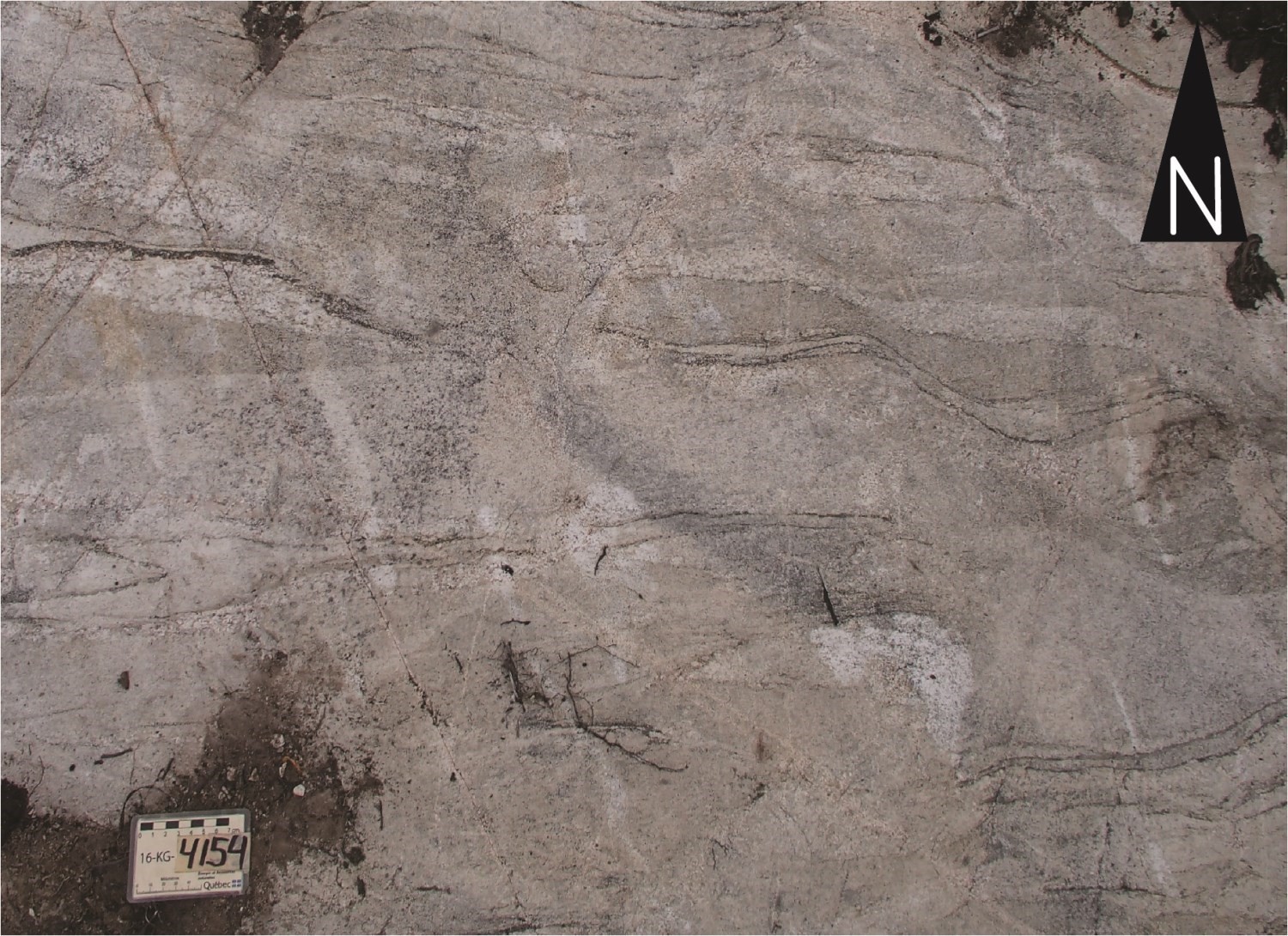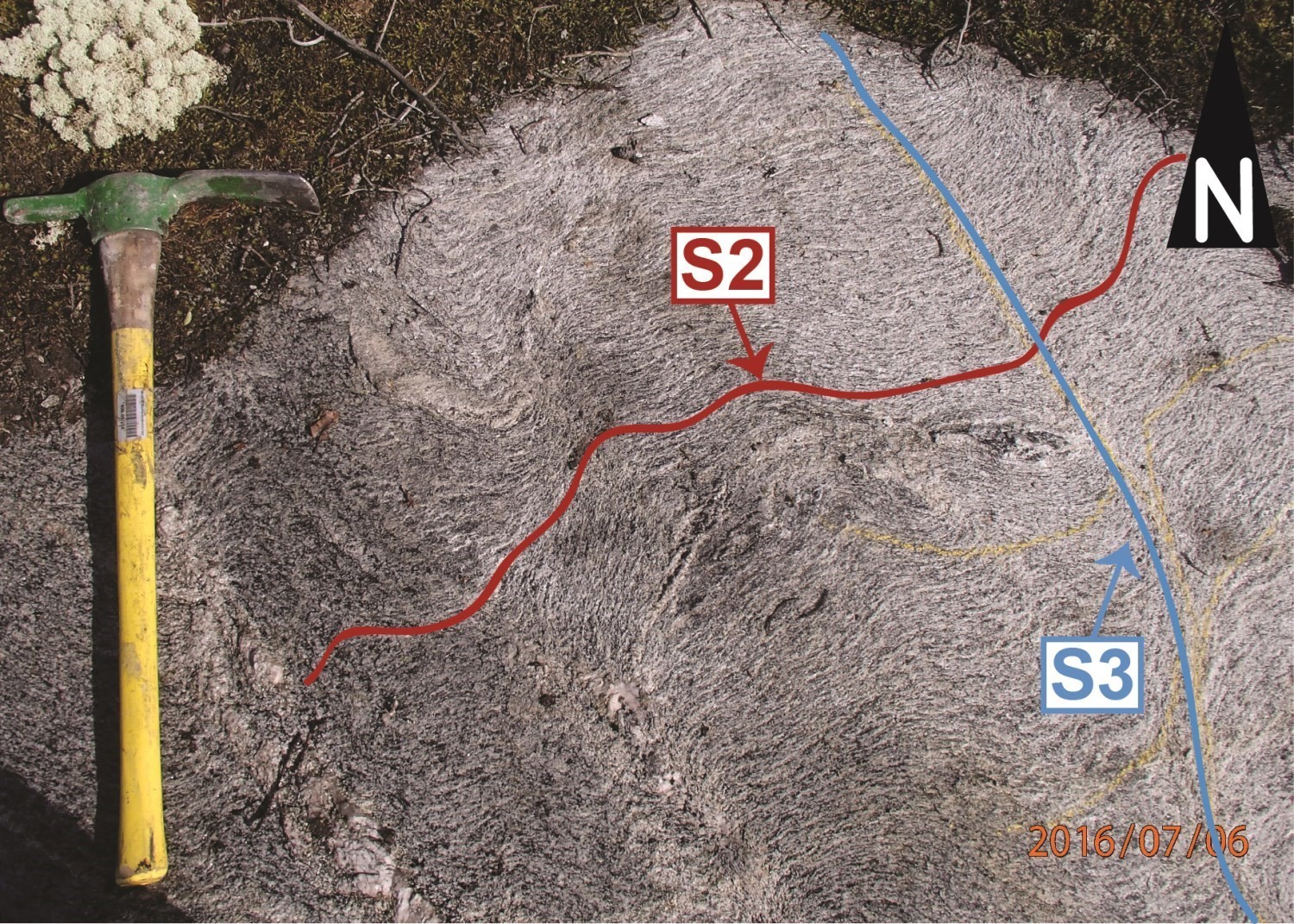
Last modified:
Translation of original French
| Author: | Franconi, 1974 |
| Age: | Precambrian / Archean / Neoarchean |
| Reference section: | |
| Type area: | The Salamandre Intrusive Suite consists of several felsic to intermediate EW-oriented intrusions located at the southern edge of the western part of the Frotet-Evans Volcano-sedimentary Belt. This unit extends over several NTS sheets (32K08, 32K09, 32K10, 32K11, 32K12, 32K06 and 32K07). All facies are exposed in the Salamandre Lake area (NTS sheet 32K10). |
| Geological province: | Superior Province |
| Geological subdivision: | Opatica Subprovince |
| Lithology: | Felsic and intermediate intrusive rocks |
| Unit type: | Lithodemic |
| Rank: | Suite |
| Status: | Formal |
| Use: | Active |
- None
Background
This unit was originally described as the « Salamandre Lake Massif » by Franconi (1974) in his report on the western part of the Frotet-Evans volcano-sedimentary band. It is renamed « Salamandre Intrusive Suite » by Morin (1997) when mapping the Ouagama Lake area (NTS sheet 32K11). Since most of the units are outcropping in the Salamandre Lake area (NTS sheet 32K10), the descriptions are mainly based on the observations made by Franconi (1974).
Description
The Salamandre Intrusive Suite contains granodiorites in its western part (NTS sheets 32K06, 32K07, 32K10, 32K11 and 32K12), while its eastern part is dominated by tonalites and diorites (32K08, 32K09 and 32K10). A granite intrusion and fine-grained felsic intrusive rocks occur locally.
Salamandre Intrusive Suite 1 (nAsam1): Granodiorite
The granodiorite of the Salamandre Intrusive Suite (Morin, 1997) is massive and pink-gray in color. Grain size varies from medium within the unit, to fine close to the contact with volcanic rocks of the Rabbit Formation (Morin, 1997). It is composed of quartz and interstitial microcline. Biotite is uniformly distributed and, in some cases, shows a weak preferential orientation. This foliation is accentuated at the edge of the unit; biotite aggregates then form irregular beds and quartz takes a lenticular shape and a granoblastic structure (Franconi, 1974; Morin, 1997). Accessory minerals include titanite, iron oxides, apatite and epidote.
Salamandre Intrusive Suite 2 (nAsam2): Diorite, Quartz Diorite and Tonalite
Diorites, quartziferous diorites, and biotite and/or hornblende tonalites are foliated, homogeneous and medium-grained with a beige to medium gray color. On the edge of the unit, these lithologies develop a gneissic structure. Under the microscope, the rock is essentially composed of sub-rectangular plagioclase (albite) variably saussuritized. Plagioclase also appears as idiomorphic or rounded phenocrysts which give the tonalite a porphyraceous structure. Interstitial quartz and accessory microcline are present. Amphibole (green hornblende) is associated with titanite, epidote, apatite and clustered biotite on the rim of plagioclase crystals. Biotite is slightly chloritized. The Asam2 unit occupies the core of a NE-SW oriented dome-shaped structure and outcrops on both sides of the northeastern part of Quénonisca Lake, at the edge of NTS sheets 32K09 and 32K10. It also corresponds to an NW-SE oriented dome south of Rocher Lake that intrudes amphibolites of the Rocher Complex (NTS sheets 32K08 and 32K09).
nAsam2a: Biotite tonalite
The biotite tonalite is a fine-grained rock having a granoblastic structure, indicative of recrystallization. Plagioclase is fresh and biotite forms small (0.5 to 1 mm) lamellae defining foliation. The unit also includes a certain proportion of medium-grained, amphibole-rich melanocratic tonalite and finely-banded biotite leucocratic tonalite (Franconi, 1974).
nAsam2b: Banded porphyraceous tonalite
Porphyraceous tonalites on the western shore of Salamandre Lake show a banding characterized by alternating thin leucocratic layers of quartzofeldspathic composition and tonalitic layers 15 to 20 cm thick.
nAsam2c: Banded hornblende tonalite
 The banded hornblende tonalite is characterized by a gneissosity represented by the alternation of centimetric to decimetric bands rich in amphiboles and quartzofeldspathic layers. It includes amphibolite xenoliths and schlieren composed of biotite and amphibole oriented parallel to gneissosity and indicative of some migmatitization. The banded hornblende tonalite also includes an amphibole-rich melanocratic facies that mainly outcrops in the southern part of Quénonisca Lake (NTS sheet 32K07) and, to a lesser extent, between Salamandre and Rocher lakes (southeast of NTS sheet 32K10).
The banded hornblende tonalite is characterized by a gneissosity represented by the alternation of centimetric to decimetric bands rich in amphiboles and quartzofeldspathic layers. It includes amphibolite xenoliths and schlieren composed of biotite and amphibole oriented parallel to gneissosity and indicative of some migmatitization. The banded hornblende tonalite also includes an amphibole-rich melanocratic facies that mainly outcrops in the southern part of Quénonisca Lake (NTS sheet 32K07) and, to a lesser extent, between Salamandre and Rocher lakes (southeast of NTS sheet 32K10).
Salamandre Intrusive Suite 3 (nAsam3): Granite and Fine-grained Felsic Intrusive Rock
The granite is massive, homogeneous and medium-grained, pinkish-gray in color. It forms an oval mass 6.5 km x 3.75 km in size between Salamandre and Quénonisca lakes.
Thickness and distribution
Rocks of the Salamandre Intrusive Suite extend over 85 km along an east-west axis and over a maximum width of approximately 41 km. This unit covers an area of 155 km2. A second intrusion of 15 km x 7 km in size and located between Rocher and Amisquioumisca lakes is also associated with this suite.
Dating
None.
Stratigraphic Relationship(s)
The Salamander Intrusive Suite intrudes amphibolites of the Rocher Complex, southeast of Rocher Lake. At its northwest edge, it also intrudes volcanic rocks of the Rabbit Formation. The western boundary of the granodiorites is largely defined by the Nottaway Deformation Corridor. The banded hornblende tonalite south of Quénonisca Lake (nAsam2c) intrudes dioritic gneisses of the Chensagi Suite (nAcng). The granodiorite and tonalite are in turn cut by mafic-ultramafic intrusions of the Rocher-Quénonisca Complex (pyroxenite and purple gabbro; nArok), intermediate intrusions of the Kakusikuch Suite (biotite hornblende diorite) and the Nottaway Pluton (biotite magnetite granite; nAntw).
Paleontology
Does not apply.
References
| Author(s) | Title | Year of Publication | Hyperlink (EXAMINE or Other) |
|---|---|---|---|
| BRISSON, H. – GOSSELIN, C. – FALLARA, F. – GAULIN, R. – DION, D.-J. | Géologie de la région du lac Rocher (SNRC 32K/09). Ministère des Ressources naturelles, Québec; RG 98-05, 22 pages. | 1998 | RG 98-05 |
| FRANCONI, A. | Géologie de la moitié ouest de la bande volcano-sédimentaire de Frotet-Evans, territoire d’Abitibi, rapport intérimaire. Ministère des Richesses naturelles, Québec; DP 265, 141 pages. | 1974 | DP 265 |
| MORIN, R | Géologie de la région du lac Ouagama (SNRC 32K/11). Ministère des Ressources naturelles, Québec; RG 97-15, 18 pages. | 1998 | RG 97-15 |


